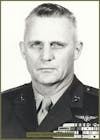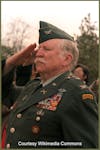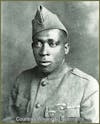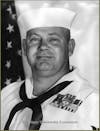Douglas Munro: The Coast Guard's Sole Medal of Honor Recipient and His Heroic Acts during WWII
Delve into the compelling story of Signalman First Class Douglas Munro, the only member of the United States Coast Guard to be awarded the Medal of Honor. Munro's heroic actions during the Battle of Guadalcanal in World War I...
Delve into the compelling story of Signalman First Class Douglas Munro, the only member of the United States Coast Guard to be awarded the Medal of Honor. Munro's heroic actions during the Battle of Guadalcanal in World War II, where he commanded a small flotilla to evacuate 500 Marines, marked a pivotal moment in the battle. Listen as we honor his legacy and recount the valorous tale of this WWII hero.
You can find the highly rated book written by Gary Williams about his story here: https://amzn.to/3IunXfb
Sources
https://en.wikipedia.org/wiki/Douglas_Albert_Munrohttps://www.warhistoryonline.com/world-war-ii/douglas-munro-saved-500-marines-from-being-slaughtered.html?chrome=1https://sofrep.com/news/douglas-a-munro-the-only-coast-guardsman-to-be-awarded-the-medal-of-honor/https://militaryperson.com/who-was-douglas-munro/https://www.uso.org/stories/2172-the-coast-guard-s-only-medal-of-honor-recipienthttps://www.cmohs.org/recipients/douglas-a-munrohttps://www.nationalww2museum.org/war/articles/douglas-munro-coast-guard-medal-of-honor
Thank you for listening to Duty & Valor!
Music by Amelie Leclerc. Artist's other music can be found at https://soundcloud.com/amelieleclerc
Please follow us on your favorite social media site.
Facebook - https://www.facebook.com/profile.php?id=100087500959777
Instagram -https://www.instagram.com/dutyandvalorpodcast/
Twitter - https://twitter.com/DutyValorPod
Duty & Valor may receive affiliate compensation from product referrals.
Welcome back everyone, on this episode of Duty & Valor I’ll tell you the story of a man who joined the US Coast Guard for the sole purpose of saving lives. A man who would disregard his own safety and continually volunteer for dangerous missions. A man who would do more than was asked of him and would sacrifice his life to extract a battalion of Marines at Guadalcanal. This is the story of Medal of Honor Recipient US Coast Guardsman Signalman First Class Douglas Munro.
Douglas Munro was born in Vancouver Canada on October 11th, 1919 to parents James, an American citizen, and Edith, who emigrated from England. And at the age of three, his family moved to Washington state. He was an accomplished musician and mastered the trumpet, harmonica, as well as percussion instruments. He was a member of the Sons of the American Legion Drum and Bugle Corps and was a member of the wrestling team at Cle Elum High School. Following high school he attended Central Washington College of Education, as he wanted to remain close to home so he could continue to be a part of the drum and bugle corps.
By 1939 Munro wanted to join the military and his sister said that he chose the US Coast Guard so he could “save lives”. He would receive his basic training at Coast Guard Air Station Port Angeles in WA, and while there he met Ray Evans and the two quickly became friends. Evans served beside Munro for the entirety of Munro’s military service. The two were inseparable and were given the nickname of The Gold Dust Twins by fellow shipmates.
Munro was first assigned aboard the cutter Spencer, but by the summer of 1941 war was looming with the Japanese, Munro and Evans volunteered to join the attack transport USS Hunter Liggett where it would eventually be sent to what would be the Pacific theater of WWII.
By 1942, the Hunter Liggett was in the waters off the Solomon Islands. These islands were a crucial location that the US needed to capture, and use, as a staging point to push the Japanese back to their home islands. In preparation for the imminent amphibious attacks, both Evans and Munro volunteered to join others in training to helm the boats that would be used to transport US Marines ashore. In addition, Munro received training as a signalman. Which meant he would be responsible for communications between the ships and the men ashore. He was then attached to a Marine unit in an attack during the Guadalcanal Campaign, where he safely landed all of the Marines.
Following this action, Munro and Evans volunteered to support US Naval staff at Naval Operating Base Cactus at Lunga Point on Guadalcanals north coast. Cactus was used as a communication relay point between the ships and the men on shore.
On September 20th, Munro quickly volunteered to lead a waterborne search and rescue operation to find the crew of a Navy aircraft that went down off of Savo Island. His boat faced heavy Japanese fire from land, but Munro was able to navigate his craft to limit the injuries to his crew and they only sustained minor injuries. The flight crew was ultimately found and rescued by a Naval float plane.
A week later on September 27th, Munro was given command of two LCTs, which are landing crafts used to transport tanks to support amphibious assaults. In addition to the LCT’s, he also was in command of eight Higgins boats which transported three companies of the 1st Battalion, 7th Marines who were leading the main assault. The landings were supported by the destroyer USS Monssen, which pounded Japanese positions to allow the Marines to safely make landfall and advance.
All of the men landed safely ashore, so the landing craft all returned to Lunga point, except for one which remained to evacuate any injured men. This sole boat was manned by Evans and Navy seaman Samuel Roberts. As the boat was close to shore, they were a target for the Japanese. Without any advanced warning, the Japanese opened up on them with heavy machine gun fire. The boat was damaged but Roberts was able to make emergency repairs that made it operational again, but unfortunately he was gravely wounded and died. Thanks to Robert’s efforts, Evans was able to retreat at full throttle, and he was able to make it back to Lunga Point where he communicated what was transpiring ashore.
Also around this time, a group of Japanese bombers forced the USS Monssen to retreat. Now lacking heavy support from the destroyer, the Marines faced a heavy counterattack by the Japanese. The Japanese were trying to isolate the Marines while cutting them off from any possible escape. The Marines lacked radios and couldn’t communicate their situation to others. So they had to resort to laying down their undershirts on a hillside spelling out the word HELP. Thankfully a Navy pilot had seen the message and communicated it back to Lunga Point.
Thanks to Evans and the Navy pilot, the men at Lunga quickly devised a plan to get the Marines evacuated. Munro was asked if he would take command of the mission and he responded, “Hell, Yes!”. He was given command of the ten boats that would make their way back. They knew that they would face heavy enemy fire when they arrived, but that didn’t slow them down. And as soon as they entered the bay, they were immediately fired upon. By this point the Monssen had returned and cleared a path to the beach for the Marines. This path was narrow and the Japanese occupied all three sides of the bay, so any Marines and any incoming or departing boats would be fired upon from multiple directions.
Munro was in direct command of one landing craft and used its 30mm machine gun to lay down suppressing fire so the men could safely get aboard the other landing craft. To Munro, his actions so far weren't aiding the Marines enough so he guided his landing craft closer to shore to place it between the Japanese and the Marines to shield them from enemy fire. During the evacuation another boat was grounded so Munro gave the command for the other landing craft to try and free it. Again, Munro maneuvered his craft and placed himself between the Japanese and the stranded boat, acting as a shield.
At this point, Evans had noticed a Japanese machine gun crew setting up position and ultimately taking aim at the landing craft, unfortunately Munro couldn’t hear Evans’ warning shouts and Munro was shot in the base of his skull and fell unconscious. The boat was eventually freed and the landing crafts withdrew with the Marines. Evans reported that Munro briefly regained consciousness, and in his final words, asked “Did they all get off?” When Evans nodded in confirmation, Munro smiled before ultimately passing away on the landing craft. Thanks to Munro’s leadership as well as the heroism of all of the Marines and the men involved in the evacuation, they were able to safely evacuate 500 Marines. These same Marines would go on to eventually defeat the Japanese at Guadalcanal.
The next day, Ray Evans placed a cross, which he built, upon Munro’s grave where he was buried at Guadalcanal.
Due to his actions that day, Signalman First Class Douglas Munro was posthumously awarded the Medal of Honor. At a ceremony at the White House on May 24th, 1943, President Roosevelt presented the medal to his parents. To date, he is the only US Coast Guardsman to receive our Nation’s highest military honor, and his name is also on the wall of heroes at the National Museum of the Marine Corps, the only non-Marine to be honored in this way.
On the day after the White House ceremony, Edith, Douglas’s mother, enlisted in the US Coast Guard. The only thing that she asked for, and received, was that she not be given any special treatment. She was the first female staff officer of the Coast Guard and was discharged as a lieutenant following the war.
In 1947, Douglas Munro’s remains were retrieved and he was reinterred at Laurel Hill Memorial Park in Cle Elum, WA.
If you want to learn more about him, there is a highly rated book written by Gary Williams that tells his story called Guardian of Guadalcanal: The World War II Story of Douglas Munro.
Thank you for listening, and if you enjoyed this week's show, we kindly ask that you follow us and leave a review and 5 star rating. A link to the book about Douglas and sources for today's show can be found in the show notes. And join us next week where we’ll tell you the story of another true American hero.




















